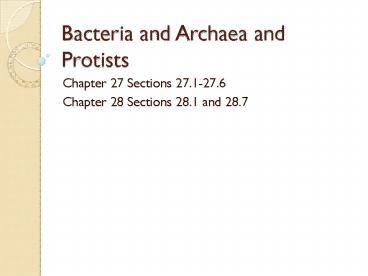Bacteria and Archaea and Protists - PowerPoint PPT Presentation
1 / 21
Title:
Bacteria and Archaea and Protists
Description:
Bacteria and Archaea and Protists Chapter 27 Sections 27.1-27.6 Chapter 28 Sections 28.1 and 28.7 Morphology Cocci Bacilli Spirilla Cell Wall What are the functions ... – PowerPoint PPT presentation
Number of Views:297
Avg rating:3.0/5.0
Title: Bacteria and Archaea and Protists
1
Bacteria and Archaea and Protists
- Chapter 27 Sections 27.1-27.6
- Chapter 28 Sections 28.1 and 28.7
2
Morphology
- Cocci
- Bacilli
- Spirilla
3
Cell Wall
- What are the functions of the cell wall in
prokaryotes? - Maintain cell shape
- Protection
- Prevent bursting in hypotonic environment
- Made of peptidoglycan
- Why is some food preserved by salting it?
- Hypertonic environment plasmolyzes bacterial cells
4
Cell Wall Structure
- What is the composition of prokaryotic cell
walls? - Peptidoglycan
- Exact components vary among species
- Some antibiotics work by preventing formation of
cross-links in peptidoglycan
5
Gram/Gram-
- Gram positive bacteria
- Stains blue/violet
- Simple cell walls with lots of peptidoglycan
- Purple/blue stain is trapped in cell wall
- Less threatening pathogens tooth decay, strep
throat - Gram negative bacteria
- More complex cell walls with less peptidoglycan
- Blue dye washes out so they stain pink (first
dye) - Outer membrane covers cell wall
- More pathogenic than gram typhus gonorrhea
- Lipopolysaccharides in outer membrane often toxic
6
Adherence
- Capsule
- Gelatinous secretion that helps cell adhere to
host - Pili
- Surface appendages used for conjugation or
adherence to host
7
Bacterial Movement
- Flagella
- Spirochetes move via axial helical filaments
- Glide via slimy chemical secretion
- Many are capable of taxis in heterogeneous
environment
8
Basic Cell
- What does the basic prokaryotic cell look like?
- Nucleoid region one circular piece of DNA
- Little protein associated with bacterial genome
- Bacterial chromosome often called genophore
9
Metabolic Diversity
- What are the four possible modes of bacterial
nutrition? - Photoautotrophs
- Chemoautotrophs
- Photoheterotrophs
- Chemoheterotrophs most bacteria are in this
group
10
Reproduction
- Binary fission, no mitosis or meiosis
- What are the methods of genetic recombination?
- Transformation
- Conjugation
- Mutations
- What are endospores?
11
Disease
- Exotoxins release poisons such as botulism and
cholera - Endotoxins seen in outer membrane of gram
negative bacteria (Salmonella)
12
Three Groups
- Methanogens
- Extreme halophiles
- Extreme thermophiles
13
Chapter 28 Protist Diversity
- Unicellular
- Rely on use of nucleus, endoplasmic reticulum,
Glogi apparatus, and lysosomes - Nutritionally diverse
- Photoautotrophs-contain chloroplasts
- Heterotrophs
- Mixotrophs-photosynthetic and heterotrophic
- Reproduction and life cycles are highly
varied-asexual or sexual reproduction
14
Secondary Endosymbiosis
- Red algae and green algae were ingested in the
food vacuole of heterotrophic eukaryotes and
became endosymbionts
15
Symbiotic relationships
- Photosynthetic dinoflagellates provide
nourishment to coral polyps that build coral
reefs - Wood digesting protists inhabit termite guts
16
(No Transcript)
17
(No Transcript)
18
(No Transcript)
19
Stains violet/blue
20
(No Transcript)
21
Where do photosynthesis and respiration take
place?































